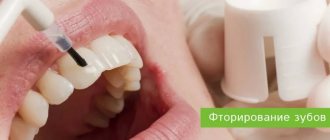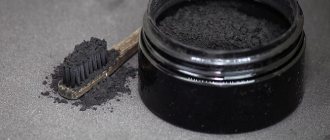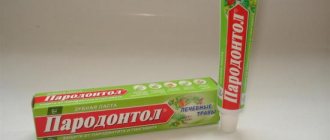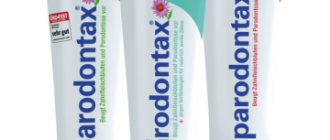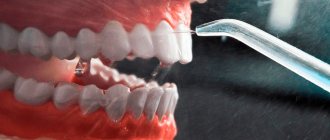Author of the article:
Soldatova Lyudmila Nikolaevna
Candidate of Medical Sciences, Professor of the Department of Clinical Dentistry of the St. Petersburg Medical and Social Institute, Chief Physician of the Alfa-Dent Dental Clinic, St. Petersburg
For many years, every second person in the street was convinced that a good toothpaste must certainly contain fluoride. Our grandparents stubbornly insisted on the importance of this element. But is fluoride really necessary in toothpaste, or does the harm of this microelement still outweigh its benefits? Let's try to figure it out.
The recommended concentration of fluoride in toothpaste is
Table 1 – recommended concentration of fluoride in toothpaste for children and adults. This is data from a very authoritative organization - the European Academy of Pediatric Dentistry (EAPD). Link to scientific publication (source).
Exactly the same dosages are recommended by the World Health Organization (WHO), as well as the FDI (International Dental Association). Previously, the approaches were slightly different, and for children from 0 to 6 years old the recommended dose of fluoride was only 500 ppm. Studies have shown the safety of using 1000 ppm fluoride in children even from 0 to 2 years old, as long as the concentration of fluoride in drinking water is not exceeded and the correct amount of toothpaste is used.
Calculation of fluoride concentration –
When it comes to calculating the fluoride concentration in toothpaste, there is sometimes a little confusion. Most often, and this corresponds to European standards, you can see that the fluoride concentration is indicated in special units “ppm”. But on Russian-made toothpastes you can sometimes see that the fluoride concentration is indicated as a percentage (% of the volume or weight of the toothpaste).
- Concentration in ppm – reflects how much so-called active fluorine is contained in the toothpaste, i.e. fluoride ions, which are formed during brushing from an inactive fluoride compound by dissociating it into ions.
- Concentration as a percentage (%) - usually means only the volume of fluoride compound in relation to the volume of toothpaste in the tube.
This indicator will not be able to tell you exactly how many fluoride ions the toothpaste contains, because... During the dissociation/decomposition of different fluoride compounds of the same concentration, completely different amounts of fluoride ions are formed. For example, if it is written that sodium fluoride in toothpaste is contained in a concentration of 0.312%, then this will correspond to the amount of fluoride ions in the amount of 1450 ppm. But in a toothpaste containing 0.312% sodium monofluorophosphate or amino fluoride, the amount of fluoride ions will be completely different, and in this case ppm will no longer be = 1450. Therefore, it is better not to rack your brains and buy those toothpastes where the fluoride concentration is indicated immediately in ppm.
But some manufacturers may indicate the fluorine concentration in % (already in fluoride ions), and then, say, 0.05% fluoride will already correspond to 500 ppm, respectively, 0.1% will already correspond to 1000 ppm, etc.
Some manufacturers add both fluoride and calcium to their toothpastes, which is done mainly for marketing purposes. A clinical study "Total and Free Fluoride Concentration in Various Brands of Toothpaste Marketed in India" published in 2015 in the Journal of Clinical and Diagnostic Research for doctors (source) found that the presence of calcium carbonate or other calcium compounds in toothpaste – will lead to a decrease in the concentration of active fluoride ions by at least 15 to 50%.
How to brush your teeth correctly
Choosing the right toothpaste is only half the battle. To achieve a visible and tangible effect, it is important to learn how to properly carry out daily cleaning. Let us remind you that the main rule of maintaining oral hygiene is regular cleaning of the enamel with a brush and paste. As for the technique of its implementation, experts in the field of dentistry provide several more important recommendations in this regard:
- from the outside, the teeth must be cleaned with vertical sweeping movements, starting from the gums (if you brush in a horizontal direction, you can damage the enamel),
- similar vertical movements should be used to clean the inner surface,
- posterior molars can be cleaned using horizontal movements, paying special attention to the chewing surface,
- Next, you should move on to the tongue - its surface must be cleaned, since it is on it that the largest number of bacteria accumulate.
It is better to learn the correct cleaning technique from childhood. This is one of the reasons why, after the appearance of the child’s first teeth, it is imperative to show him to the dentist for preventive care. Even if you are not sure as an adult that you brush your teeth correctly, a professional dentist will definitely help you with this.
Anti-carious effect of fluoride –
Fluorine is one of the most abundant substances on earth (13th place). Fluoride ions are present in the body of every person in a certain concentration - they enter our body mainly in chicken meat, fish, cereals, tea and wine, dairy and other products. And what is most important for teeth is that fluoride ions, after absorption in the intestines, will be found not only in the blood serum, but also in the secretion of the salivary glands - in saliva. Why is it important…
The fact is that tooth enamel consists of a substance with a high calcium content - hydroxyapatite. Cariogenic bacteria in the oral cavity, metabolizing food debris, produce lactic acid, which reduces the pH of the oral fluid (i.e., increases its acidity). When the pH of the oral fluid drops below a critical level, and for dental enamel hydroxyapatite the critical level is pH 5.5, the process of demineralization occurs, i.e. dissolution of hydroxyapatite crystals.
Thus, demineralization is nothing more than the very initial stage of carious tooth destruction. At the very beginning, this process is still reversible, because At first, only the density of the enamel decreases - without the formation of a defect on the surface of the tooth. However, if exposure to acidic pH continues, carious defects will form at the site of demineralization areas.
Fluoride ions contained in saliva or supplied with toothpaste can reduce the degree of demineralization of enamel at an acidic pH of 5.5 and below. The fact is that fluorine ions are adsorbed on the surface of hydroxyapatite crystals, turning it into a new compound - “fluorohydroxyapatite”. This compound is already much more resistant to acids than ordinary hydroxyapatite (the critical pH value for it will no longer be 5.5, but approximately 4.5).
Important: as soon as you drink a sweet drink or don’t brush your teeth after eating, bacteria begin to process sugars/food residues, releasing lactic acid. This acid is the triggering factor in the occurrence of caries. Fluoride ions make tooth enamel less susceptible to acid (prevent the dissolution of hydroxyapatite by acid). Therefore, fluoride ions contained in saliva, as well as fluoride in toothpaste, help reduce the risk of developing caries.
Additional effects of fluoride on teeth –
- Reduces the rate of plaque formation - fluoride has a bactericidal effect on pathogenic microorganisms - due to the inhibition of intracellular enzymes (glycolytic enzymes, as well as H+ ATPases). In fact, fluoride is a natural antiseptic, thereby reducing the rate of proliferation of cariogenic bacteria in the oral cavity.
- Increases the remineralizing potential of saliva - it has been proven that the presence of fluoride ions in sufficient concentrations in the blood plasma increases the functional activity of the salivary glands.
Good salivation is very important for the prevention of caries, because... Saliva has a buffer capacity - it helps neutralize the acidic pH in the oral cavity. In addition, in addition to fluoride ions and enzymes, saliva also contains calcium and phosphorus ions. It is thanks to the calcium contained in saliva that the processes of mineralization/remineralization of tooth enamel occur, i.e. its saturation with calcium. These processes compensate for the process of demineralization, which occurs under the influence of acid produced by cariogenic microorganisms.
But if there is insufficient fluoride in the body, not only caries develops, but also osteoporosis. At the end of the article we will describe the consequences of a lack of fluoride in the body in more detail.
What could be the consequences of microelement deficiency?
At the same time, fluorine is an important substance for our body. It affects the metabolic processes in it, promotes the removal of dangerous and heavy metals. Without it, immunity will not be supported; iron is poorly absorbed.
A lack of fluoride is reflected in the bones - they become bent, become brittle and brittle, and when fractured, they do not heal well.
Teeth also largely depend on the lack of an element: the enamel becomes thinner and becomes unusable, allowing the development of caries.
An excess of fluoride does not bring anything good either . It is not he himself, but a supernumerary amount of him. True, it can be controlled so that there is no harm. After all, too much fluoride leads to serious complications.
History of the use of fluoride in toothpaste -
Fluoride was first added to Tanagra toothpaste in 1890, but it was not widely used. In the 1940s, a second wave of fluoride toothpastes began appearing in the United States, but their use was initially criticized by the American Dental Association (ADA). Only after numerous clinical studies were conducted by Procter & Gamble did they receive ADA approval for their industrial production in 1950.
In parallel with this, in 1945 the technology of systemic fluoridation of drinking water was first used in the USA. Initially, this was implemented in 4 American cities (Evanston, Newberg, Grand Rapids and Brantford), where 1 mg of fluoride per 1 liter of water was added to drinking water at treatment stations. As a result, a reduction in the incidence of caries in the population by approximately 50% was achieved.
Thus, the first toothpaste with fluoride, which was clinically proven effective against caries, was released by Procter & Gamble under the Crest brand (USA). After 5 years of observation, dental associations from different countries recognized the high anti-caries effectiveness of fluoride-containing pastes, provided they are regularly used for oral hygiene.
Clinical researches
Clinical studies have proven that regular use of professional toothpaste ASEPTA REMINERALIZATION improved the condition of the enamel by 64% and reduced tooth sensitivity by 66% after just 4 weeks.
Sources:
- Report on the determination/confirmation of the preventive properties of personal oral hygiene products “ASEPTA PLUS” Remineralization doctor-researcher A.A. Leontyev, head Department of Preventive Dentistry, Doctor of Medical Sciences, Professor S.B. Ulitovsky First St. Petersburg State Medical University named after. acad. I.P. Pavlova, Department of Preventive Dentistry
- Study of the clinical effectiveness of treatment and prophylactic agents of the Asepta line in the treatment of inflammatory periodontal diseases (A.I. Grudyanov, I.Yu. Aleksandrovskaya, V.Yu. Korzunina) A.I. GRUDYANOV, Doctor of Medical Sciences, Prof., Head of Department I.Yu. ALEXANDROVSKAYA, Ph.D. V.Yu. KORZUNINA, asp. Department of Periodontology, Central Research Institute of Dentistry and Maxillofacial Surgery, Rosmedtekhnologii, Moscow
- Clinical studies of antisensitive toothpaste “Asepta Sensitive” (A.A. Leontyev, O.V. Kalinina, S.B. Ulitovsky) A.A. LEONTIEV, dentist O.V. KALININA, dentist S.B. ULITOVSKY, Doctor of Medical Sciences, Prof. Department of Therapeutic Dentistry, St. Petersburg State Medical University named after. acad. I.P. Pavlova
Fluoride compounds in toothpastes –
Below we will present the main characteristics of the fluoride compounds most commonly found in toothpastes.
- Sodium monofluorophosphate - this compound slowly dissociates into ions, and therefore active fluoride ions are released from it quite slowly. Consequently, toothpastes with this component will be ineffective if a person brushes his teeth very quickly (no more than 2 minutes). But if you brush your teeth for at least 3-4 minutes, then sodium monofluorophosphate will be no less effective than the next component - sodium fluoride.
- Sodium Fluoride – Sodium fluoride in toothpaste easily and quickly dissociates into ions, releasing active ionized fluoride.
It has very high remineralizing activity, due to which teeth are quickly strengthened. A good anti-caries effect is quickly achieved, including in children. In pediatric practice, the use of sodium fluoride is preferable to sodium monofluorophosphate, because Children spend significantly less time brushing their teeth than adults. A big plus of toothpastes with sodium fluoride is that they are not only effective, but also have a reasonable price (if you compare them with toothpastes based on the next fluoride compound - aminofluoride). - Aminofluoride (olaflur) - this compound has a very high remineralizing ability, even greater than that of sodium fluoride.
It should be noted that amino fluoride, in addition to affecting the enamel during brushing, creates a thin film on the surface of the enamel, which remains on the teeth even after brushing. This leads to the fact that fluoride will penetrate into the enamel from such a film for a long time. Aminofluoride is the most progressive fluoride component today, which is used in both adults and children. For example, it is used in the professional line of toothpastes produced by Colgate-Palmolive - the Elmex series of toothpastes for children and adults. A big advantage of toothpastes with amino fluoride is the faster dissociation of this compound into fluoride ions (even compared to sodium fluoride). The downside is the higher price. - Tin fluoride – tin fluoride has a high remineralizing ability, but is inferior in this to amino fluoride. Currently, tin fluoride is used in toothpastes of the Blendamed PRO-Expert series. In the past, pastes with stannous fluoride had disadvantages - they could lead to dark staining of fillings and areas of enamel demineralization, but modern pastes no longer have such disadvantages.
Important: you can find toothpastes in which the total fluoride concentration will be, for example, 1450 ppm, but the paste will contain not one, but 2 different fluoride compounds. Typically, a combination of monofluorophosphate and sodium fluoride is found. This is done to save money, because... sodium fluoride is the more expensive component. It turns out that although you will know the total concentration of fluoride in such a paste, you will no longer know how much of the cheap and how much of the expensive component it contains.
Fluorine and fluorides are not the same thing
Often, opponents of the use of fluorine confuse key concepts: fluorine is a reactive gas that is poisonous to the human body, and fluorides, its octane-based derivatives, are absolutely harmless. Only fluorides (such as sodium fluoride) are used to make toothpaste. Moreover, their concentration in a tube of paste is strictly regulated.
ATTENTION! According to regulations, the permissible concentration of fluoride in toothpaste ranges from 1350 to 1650 ppm. This indicator depends on whether the paste is therapeutic and prophylactic or is intended purely for the prevention of caries (1ppm = 0.0001%).
Best Fluoride Toothpaste – Editor's Choice
Below we will present one of the best fluoride toothpaste options for teenagers and adults.
ELMEX® toothpaste –
instructions for use- manufacturer: Colgate-Palmolive,
- active substances: aminofluoride,
- total fluoride content – 1400 ppm
- price: 75 ml – from 210 rub.
Comments: an excellent paste for strengthening enamel and preventing caries. Contains a high concentration of amino fluoride, as well as high-quality abrasive and polishing components. It does not contain antiseptics or other additives that can only be used periodically, so it is suitable for daily long-term use. The Elmex series of toothpastes also includes toothpastes for children - with aminofluoride concentrations of 500 and 1000 ppm.
→ The best fluoride toothpastes for children
Substance poisoning - symptoms
A sufficient, but not excessive intake of this substance into the body helps strengthen the enamel and improve the condition of the teeth. However, overdose can cause serious damage. Usually in such cases they talk about the development of fluorosis. Among the most common varieties of this pathology, experts in the field of dentistry distinguish spotted, streaked, chalky-speckled, erosive and destructive forms. Let's look at them in a little more detail:
- spotted - involves the formation of small light spots on the enamel, which can merge with each other, forming one large spot,
- streaked - light stripes of different shapes appear on the incisors, which can also combine to form fairly large strokes,
- chalky-mottled - the surface of the teeth becomes dull and yellowish, while many dots and specks appear on its surface. Pathological abrasion of the enamel is noted, due to which the dark color of dentin begins to appear,
- erosive – leads to the formation of numerous specks, but primarily affects the chewing surface of the teeth,
- destructive – dental tissues become fragile and quickly break down.
The photo shows dental fluorosis.
An excess of fluoride in the body also affects the condition of the skeletal system. One possible complication is osteoporosis, in which the bones become soft and calcium is quickly washed out of them. Pathological changes occur in the joints, causing ankylosis to develop. In advanced cases, the liver and kidneys suffer.
Excess fluoride can be harmful -
It should be noted that fluoride is not absorbed and does not penetrate the mucous membrane of the oral cavity and, accordingly, if you do not swallow toothpaste, fluoride cannot enter your body from toothpaste. When brushing your teeth, fluoride ions can only penetrate the tooth enamel. However, young children may swallow small amounts of toothpaste. This can cause absolutely no harm (provided there is a normal concentration of fluoride in drinking water).
Fluoride is toxic when it is ingested only in very high concentrations. The probable toxic dose is 5 mg per 1 kg of body weight. Example: in a 20 kg child, fluoride poisoning can only be achieved by simultaneously swallowing the entire 75 ml tube of toothpaste - with a fluoride content of 1000 to 1500 ppm (i.e. toothpaste for adults). As for the development of dental fluorosis, it is caused by excess fluoride in drinking water, and not by fluoride toothpaste.
Fluorosis and excess fluoride in drinking water –
There is a dental disease called fluorosis.
It develops due to increased fluoride content in drinking water. With fluorosis, spots of various colors and/or grooves appear on the tooth enamel. Important: this disease can only occur when too much fluoride is consumed between the ages of 0 and 6-7 years, because It is during this period that the formation and development of tooth buds occurs (the period from 0 to 2 years is especially critical). For older children and adults, consuming higher concentrations of fluoride does not in any way lead to the development of fluorosis. In most regions of Russia, drinking water contains a low concentration of fluoride, but in 21 regions it is increased. An increase in fluoride concentration may be of natural origin or associated with human activity. An increased dosage of fluoride in water is considered when its content exceeds 1 mg per 1 liter (24stoma.ru).
Regions with high fluoride content –
- The Moscow, Tver, Ryazan, Sverdlovsk, and Chelyabinsk regions have an increase in the fluorine content of natural origin (in addition, in the Ryazan and Sverdlovsk regions, very large coal-fired thermal power plants additionally increase the level of fluorine in water).
- In the Kemerovo, Irkutsk, and Sverdlovsk regions, as well as in the Krasnoyarsk Territory and the Republic of Khakassia, the increase in fluoride in drinking water is associated with the presence of aluminum and cryolite production plants.
- In the Vladimir, Moscow, Volgograd, Ryazan regions, Udmurtia and Mordovia, the increase in fluoride in drinking water is associated with the presence of glass factories.
- In the Kostroma and Kirov regions, the increase in fluoride content in water is associated with factories for the production of organic phosphorus fertilizers.
Important: you must understand that the increased fluoride content in drinking water should be taken into account only if you drink or use running unfiltered tap water or water from underground sources (artesian) for cooking. But if you use filters to purify water, they can retain more than 80% of fluoride dissolved in water.
Thus, water filtration systems operating on the principle of reverse osmosis remove approximately 84% of fluorine from water, and carbon filters remove at least 81% of fluorine (this was proven by research by Brown MD and Aaron G., published in the journal “Pediatr.Dent” in 1991 year). Therefore, even if you live in regions with high levels of fluoride in water, your fluoride consumption may be lower than normal if you use such filters.
How to remove excess substance from the body
There are methods that allow you to remove excess fluoride from the body, but they give the desired result only if the pathology is in the initial stages of its development. Here are the main ways to combat intoxication with this element:
- iodine – promotes the excretion of the substance in the urine, so it is recommended to increase the consumption of foods rich in this component: strawberries, lingonberries, beans, potatoes,
- boron – also effectively removes fluoride and is found in high concentrations in honey, nuts, dates, avocados, prunes,
- selenium – blocks the activity of an excess element, found in sufficient quantities in Brazil nuts,
- dry sauna – helps remove accumulated toxic substances through sweating.
Consumption of iodine-containing products helps remove the substance from the body.
But before moving on to measures to remove the substance, it is necessary to limit its entry into the body. For a while, you will have to give up foods with a high content of it, switch to clean bottled water, and stop using fluoride-containing hygiene products.
Fluoride intake standards for children –
The US National Academy of Sciences, as well as the US Environmental Protection Agency (USEPA), have recommended the following doses of fluoride intake, which are considered safe for health in general and for the development of fluorosis in particular.
Table 2 is the recommended total daily fluoride intake for children 0 to 19 years of age. Link to scientific publication (Source)
In this guideline, the suggested total daily intake for children 0 to 6 months of age is 0.01 mg fluoride per day in all beverages and foods. This means you must account for all of your baby's water intake (including that you use to dilute formula), as well as that contained in other foods or supplements.
Can fluoride toothpaste cause fluorosis?
As we said above, fluorosis can only occur in those children who had an increased consumption of fluoride between the ages of 0 and 6-7 years. An extremely important role in this can only be played by the consumption of drinking water with a fluoride concentration of more than 1 mg per 1 liter of water. Fluoride toothpastes themselves cannot cause fluorosis, and drinking water plays a primary role in this.
Pastes containing fluoride can only increase the risk of fluorosis, and only under conditions that there is actually an increased concentration of fluoride in drinking water, and also if the child swallows a large volume of paste. As for the latter, this is why children under 6 years of age are recommended to brush their teeth with a pea-sized amount of toothpaste.
The following conclusions should be drawn from this. Firstly, in the absence of an increased concentration of fluoride in drinking water, fluoride toothpastes cannot cause fluorosis (or increase the risk of its development). Secondly, if there is an increased concentration of fluoride in drinking water, you should use toothpastes with calcium that do not contain fluoride.
Can it be used by children?
When choosing a product for children's teeth, it is important to assess the possible risks - whether it will bring more benefit or harm in your particular case. And to do this, you should first show your child to the dentist and consult with him about purchasing the most suitable toothpaste.
You should also take into account that most young children swallow part of the paste during brushing, and this can cause undesirable consequences, including stomach and intestinal upset. So, the concentration of the component should not exceed 1500 ppm1 - this is how this indicator will be indicated on the packaging, indicating how much of the substance is contained in this paste.
For a child, you need to choose only children's toothpaste
However, modern manufacturers also produce fairly effective and safe fluoride products for children, which provide excellent prevention of childhood caries. But it can only be used in courses and according to the indications of a pediatric dentist.
European Fluoride Directive –
The European Academy of Pediatric Dentistry (EAPD) recommends the prophylactic use of fluoride toothpaste for everyone, including pregnant women, as a primary preventative measure against dental caries. The most effective way to prevent dental caries is to brush your teeth twice a day, which should be achieved not only by using toothpaste and a brush, but also by flossing.
Parents should start brushing their children's teeth with fluoride toothpaste as soon as the first tooth emerges. For this, the concentrations recommended by the European Academy of Pediatric Dentistry (EAPD), indicated in Table 1, should be used. Thus, in children from 6 months to 2 years, the fluoride concentration in the paste should be 500 ppm, in children 2-6 years old – 1000 ppm , over 6 years old and adults – 1450 ppm.
Recommendations also include - 1) After brushing their teeth, children should spit out the toothpaste and not rinse their mouth with water afterwards. 2) Parents should use the recommended amount of toothpaste and concentration of fluoride, and assist or supervise their children with brushing their teeth until at least 7 years of age. All of the above EAPD recommendations apply subject to normal levels of fluoride in drinking water (source).
Tips for choosing dental hygiene products
In order for daily cleaning to be as effective as possible, you need to carefully consider the choice of toothpaste. It is best to consult your dentist in this matter and give preference to the product that is most suitable for your specific case. All toothpastes on the market can be divided into three independent categories:
- hygienic – used for daily cleansing of enamel and aromatization of breath,
- medicinal – they contain active additives that, when interacting with damaged or inflamed tissues of the oral cavity, help stop pathological processes,
- therapeutic and prophylactic - also contain active components, but in lower concentrations, prevent the development of many dental diseases - teeth and periodontal tissues.
When choosing a toothpaste, carefully study its composition. You need to
choose which toothpastes contain fluoride, or give preference to a product without this component, taking into account the current condition of the teeth and oral cavity. The dentist will help you with this after examining and assessing the current condition of the enamel.
If there is insufficient fluoride in the body, it develops -
Firstly, when there is insufficient fluoride in the body, caries develops first of all. Most people do not receive the proper amount of fluoride through food and water, so the lack of concentration of fluoride ions in saliva must be compensated by using fluoride toothpastes. Comparative studies of the use of toothpastes with and without fluoride have shown that if you refuse to use fluorides, the growth of caries occurs at least 35-40% faster, and there is also a faster formation of microbial plaque and hard tartar.
The second important point is that with a lack of fluoride in the body, not only caries develops, but also the risk of osteoporosis increases. Scientists have long noticed that insufficient fluoride intake contributes to a decrease in bone mass, as well as an increase in bone fragility. That is why sodium fluoride in tablets for oral administration is used in complex therapy in the treatment of osteoporosis (to increase bone mineral density).
The importance of trace elements for the body
From the above, it is quite clear that if there is an excess of fluoride, nothing good will come from brushing your teeth with a special paste. Wanting to improve their health in this way, you can achieve the opposite result - damage bone tissue and destroy enamel.
IT IS IMPORTANT TO KNOW! Fluoride has a strengthening effect on hard dental tissues, protects against caries and prevents gum disease, and minimizes bad breath.
The resulting condition is characterized by the following symptoms:
- brittle bones;
- decreased hemoglobin;
- compaction of ligaments;
- sudden weight loss;
- limitation of motor ability.
Those diagnosed with diabetes mellitus should be especially careful when using this paste, which means saturating the body with fluoride.
To prevent fluoridation from causing harm, it should be done only for medical reasons, such as, for example, the appearance of carious lesions or a general lack of this halogen in the body.
When replenishing it or using cleansing for preventive purposes, it is important to know when to stop and not to overdo it. Then the return will be effective and the benefit will be.
Use of fluoride in toothpastes: summary
- The most effective fluoride compounds - which have the highest anti-caries and remineralizing activity - are sodium fluoride and aminofluoride (olaflur). It is advisable to buy pastes with these components.
- When you should not use paste with fluoride - only in children from 0 to 6-7 years old living in regions where the fluoride content in drinking water exceeds 1.0 mg/liter. Thus, they are safe for children over 7-8 years of age and adults even in regions with high levels of fluoride in drinking water.
- Information about the possible harm of fluoride - the only harm of fluoride is the possible development of dental fluorosis. This disease develops only in children, which is due to the fact that for the development of fluorosis, it is necessary that increased dosages of fluoride affect the teeth precisely during the period of their formation and eruption, i.e. in the period from 0 to 6-7 years. Fluorosis can be found, as a rule, only in regions with high levels of fluoride in drinking water.
An analysis of information on this topic has shown that most sites on the Internet disseminate false information about the benefits or harms of various components of toothpastes. The most superficial analysis shows that most of these articles were written not by dentists, but by ordinary programmers and bloggers, for example, with the aim of increasing traffic to their projects. Another reason for such information chaos is the competitive wars of toothpaste manufacturers.For example, manufacturers of fluoride-free toothpastes post custom articles about the dangers of fluoride toothpastes in various blogs and forums... Sellers of ionic toothbrushes, who say that their brushes can be used without toothpaste at all, write articles about the total harm of all toothpastes in general. paste Those who want to make extra money on “natural” toothpastes from Thailand are silent about the fact that cheap abrasives in such toothpastes scratch and spoil the enamel of teeth... We hope that our article: Fluoride for teeth - benefits and harms - turned out to be useful to you!
Sources:
1. Higher professional education of the author in dentistry, 2. The European Academy of Paediatric Dentistry (USA), 3. National Library of Medicine (USA), 4. The National Center for Biotechnology Information (USA), 5. “Therapeutic dentistry. Textbook" (Borovsky E.V.).
Choosing a brush - expert advice
Another mandatory attribute of daily oral care is a brush. Her choice also needs to be taken seriously, and dentists give the following advice on this matter:
- the head should not exceed 3 cm in length,
- it is better to choose models with artificial bristles, since natural ones create favorable conditions for the growth of bacteria,
- The ribbed back surface of the head is designed to clean the tongue - there is no need to additionally purchase a special scraper.
It is important to choose the right toothbrush.
If you have sensitive gums that are prone to inflammation and bleeding, it is better to give preference to a brush with soft bristles. But keep in mind that it will be worse at cleaning the enamel from plaque, so the procedure must be especially intense. Hard brushes are intended to be used according to indications - otherwise they can injure the gums and enamel and do more harm than good.
Echoes of the arms race
Until the mid-20th century, only specialists knew about fluoride. Everything changed in the 1940s, when the United States turned to it during the development of atomic weapons - the chemical was needed to process uranium ores. Then they tried to use it as a component of rocket fuel, but abandoned this idea due to the high toxicity of the substance.
Fluorides are still used in industry today, so industrial emissions contain these substances. These are components of freons, which today are considered the main destroyers of the ozone layer. Fluorides are present in some medications; for example, fluorouracil is a well-known antitumor agent.
Few people know that fluorine is used to produce Teflon-coated cookware. The real name of Teflon speaks for itself - polytetrafluoroethylene. This material is also called fluoroplastic.
Fluorides are still used in the United States for antibacterial water purification. This method began to be used in the 1940s, when there was an urgent need to find a means for disinfection and there was little concern for safety. In countries such as Finland, Canada, and Israel, water fluoridation was abandoned.
Which toothpastes are better?
The question arises: “If fluorides are so dangerous, wouldn’t the solution be to abandon them altogether?” Dentists do not have a clear opinion on this matter. On the one hand, fluoride compounds are toxic, and on the other, they protect tooth enamel. However, given their ability to accumulate in the body, it is better to opt for products that do not contain fluoride.
You also need to take into account that toothpastes are filled with other, no less dangerous chemicals. Among the main anti-heroes is sodium lauryl sulfate, which manufacturers designate with the abbreviations SLS and SLES. This substance was previously used to wash engines, and is now a component of hygiene products. It is contained not only in toothpastes, but also in shampoos, shower gels, and shaving foams.
Scientists from Oslo believe that SLS provokes ulcerative lesions of the oral cavity, causing a disease such as aphthous stomatitis. They also suggest that this component dries out the oral mucosa.
If you want to protect yourself from the harmful effects of fluoride, then today there are every opportunity for this. The market is replete with toothpastes that do not contain this “suspicious subject” at all. They contain other active ingredients to destroy harmful bacteria, such as zinc. It slows down the formation of plaque and tartar well.
Calcium compounds are also used as an alternative to fluorides: calcium citrate, calcium pantothenate, calcium lactate, calcium glycerophosphate, synthetic hydroxyapatite. When the composition contains such compounds, you will not find fluorides there. Also, natural ingredients are included in toothpastes, for example, calendula, eleutherococcus. This is understandable, since calendula is one of the most powerful plants in terms of anti-inflammatory effects. Here is just a short list of fluoride-free toothpastes: PresidentUnique, Rocs, Biocalcium, Maximum, Asepta.
Dangerous enemy or protector of teeth?
We must pay tribute to fluorides - they are required by the body because they are part of the tooth enamel and skeleton. Along with calcium, phosphorus and magnesium, they are necessary for bone growth. However, to replenish their reserves, a person more than has enough fluoride-containing products and drinking water. The daily requirement of an adult for this substance is only 3-4 mg.
A lack of fluoride is harmful to humans, as is its excess - in this case, growth and bone mineralization are impaired, and tooth enamel is destroyed. It is no coincidence that calcium fluoride is found in many organisms. This compound was found in plants: onions, lentils, tomatoes, hazelnuts, green tea. They are also found in ordinary water.
In some regions, the water is oversaturated with fluoride, so people there suffer from a disease such as fluorosis. At the same time, the condition of not only the teeth, but also the bones deteriorates. The main symptom of the disease is yellow or brown spots appearing on the tooth enamel. Treating this pathology is extremely problematic.

